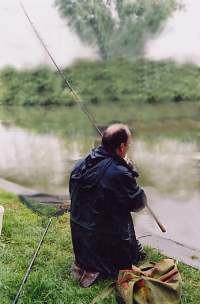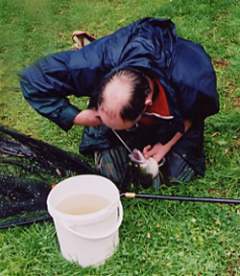Our little posse isn’t made up of big zander hunters with a string of doubles to their names. But we have evolved an approach which produces fish consistently. And it’s a lot more interesting than bivvying up behind a battery of rods on some far-flung drain for days (and nights….) on end.
While the better fish are undoubtedly a difficult quarry, which demands time and commitment, we view schoolies in the 2 – 8lb class as a fun fish, which provides vital light relief before the serious business of the winter pike campaign gets under way.
The hit and run approach
The tackle and the tactics are dead simple. If you want to catch them for the first time, and learn a bit about them along the way, try our hit and run approach to tackling rivers. Moving water has a major advantage over drains and stillwaters. You can use trotting tactics to find the fish. If locating the quarry is seven-tenths of the problem, any method which enables you to cover the water has to offer the would-be zander angler much shorter odds than the conventional static approach. Float fishing has a lot of other advantages, when you’re hunting a highly-mobile predator with the zander’s unique feeding habits. So let’s start with the tools you need to do the job.
|
|
| like Chris is using here |
TOOLING UP
Rods and reels – go for the soft option
There’s no need to splash out on new rods and reels if you already fish for pike or even carp. While many favour softer rods – perhaps with a 2 – 2.5lb test curve – to absorb the fish’s violent head-shakes, you can get by with something a little stiffer to start with. Either way it helps if the rod is light enough to hold, because you’ll need it in your hands most of the time to work a trotted bait properly.
Lines – braid is best
There’s no point fishing for zander with light lines – not least because pike often take baits intended for zander. I prefer a floating braid like Fireline or Whiplash, in 20 or 30lbs BS; both for total security and because I can usually bend hooks out of snags without leaving a tethered bait ready to kill the next zander, pike or grebe that comes along.
Some think mono’s added stretch helps stop hook pulls when a fish starts headbanging like a Status Quo reunion. I abandoned it because it’s easier to trot a river with a floating line, which enables you to set the hooks at long range. If you do plump for mono, there’s no point going under 12lbs BS, and 15lbs is safer.
You’ll also need to grease it, to stop it sinking and catching snags, or dragging the float off course when you try to straighten the line.
A wire trace is mandatory
Wire traces are essential to guard against the risk of a bite-off from the zander’s sharp teeth, or an “accidental” pike encounter. Caliber Wonderwire in 15lbs looks more like cotton than wire, so you can see why many zander anglers swear by it. You might feel more comfortable using the 24lbs strain, or the new Fox Soft Steel wire, which is rated at 25lbs. Super-supple 49-stranded wires, like those mentioned above, are fine for deadbaiting. They can sometimes tangle when a livebait flutters and takes a turn of wire around the top treble. If you’re happier with something stiffer, try 30lbs Fox Easy Twist – it’s thin for it’s breaking strain, but stiff enough to stop most tangles.
Partridge and Kamasan are my hook choice
Hook choice is a personal thing, but both Partridge Z3 and Kamasan’s semi-barbed Pike Trebles offer sharpness, strength and ease of removal. Sizes six and eight are the most useful.
Trace making
Traces need to be at least 18″, or preferably 24″ long, because trotting works best with weight attached to the wire and a longer trace enables you to vary the distance between the weight and the bait to tweak presentation. If you’re using one of the hi-tech wires, it’s best to attach the hooks via knotless knots sheathed in shrink tube, to stop the coils working loose. A strong swivel is attached to the top end, using a half-hitch and a crimp to secure the tag end. If you feel safer with one of the seven-stranded wires made by Fox, Drennan, ET etc, check out Budgie Burgess’s guide to trace making, which appeared in: Tackle Workshop – Trace Making.
Floats – two choices
So what about floats then. There are two choices, through-the-middle sliders like the Drennan Pikers; or a waggler attached bottom-end-only. Both have their good and bad points.
Through-the-middle floats are much easier to control in running water. You can straighten the line without pulling them under and hold them back on a tight line so the bait flutters up in the water. Their drawback is the resistance of pulling through them when you tighten down on a take, which can muffle the force of the strike and even spook a shoal with the disturbance they make. You can’t change them without breaking your end tackle down and they have one obvious limitation when it comes to fishing on after dark – you can’t stick a light on them.
|
|
| from another zander |
Wagglers can be attached via a snap link swivel, which means you can change floats quickly to cope with different baits, varying flow rates or the onset of darkness when you’ll need a float with a light source for obvious reasons.
After much mucking about, we’ve evolved a float which is basically a discarded peacock waggler with the tube from a medium Starlite glued on the top with Araldite and a polyball slid up to the tube. It looks daft (until it gets dark…) but it’ll easily hold up a small egg sinker or three or four swan shots. Wagglers are harder to keep on the straight and narrow but they have the distinct advantage that they fold flat as you tighten into a fish and you can literally wind down gently and feel for the fish on the end before bending into it. If it isn’t there, slacken off and the float will pop up and the bait will resume its trot, without the fish-scaring splash.
And all the other bits and pieces
The rest of the tackle is simple – rod, landing net and bait; along with a small shoulder bag containing spare bits and pieces and unhooking gear. If you’re livebaiting, you’ll need a bucket and aerator to keep the baits in good condition. Under no circumstances do we condone moving baits from one water to another, so you’ll also need a pole, maggots and a few rigs to catch some roach and skimmers.
Deadbaits are a lot more convenient and can be just as effective. The best are small coarse fish in the 2 – 4″ size, with roach a consistent performer. More exotic baits like eel-section, lamprey and even smelt are worth a go, but sea deads are generally a waste of time. None of this should break the bank and the key to catching is a rig which enables you to search the maximum amount of water as quickly as the flow permits, coupled with the mobility to keep on the move until you find the zander.
Next time, we’ll do just that.
Coming soon: Part 3 – ‘Catching Zander, Mobile Style’












